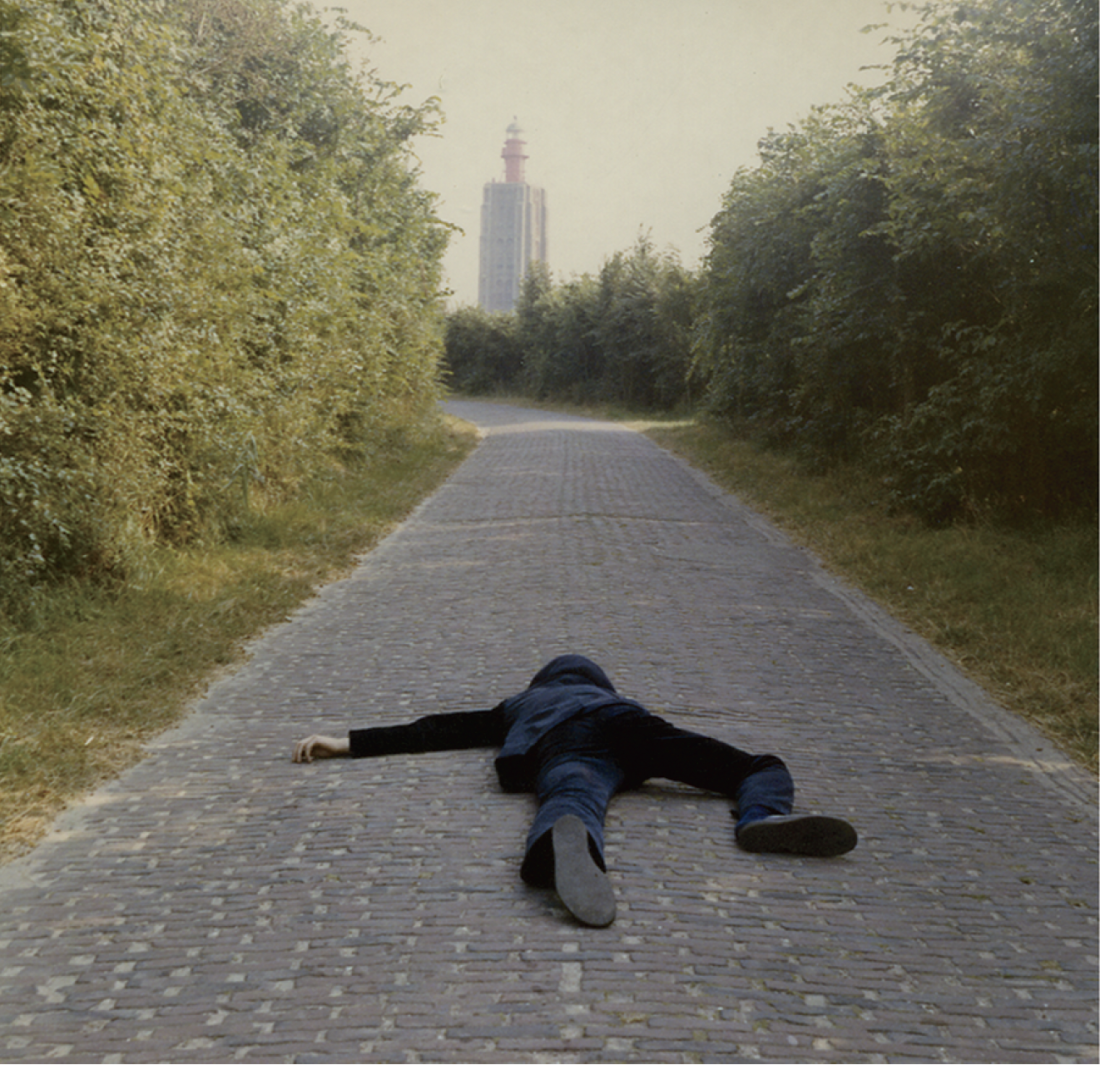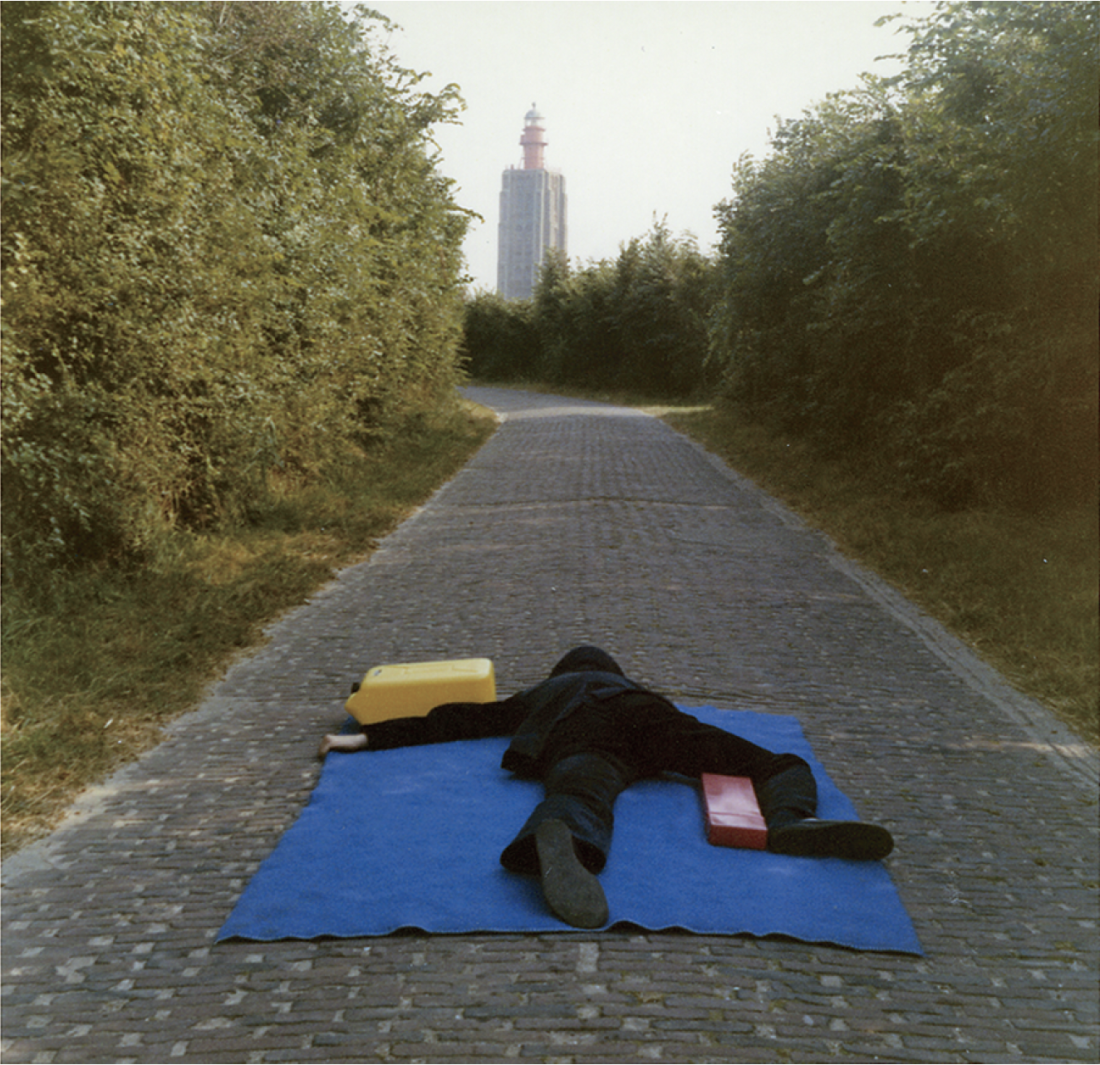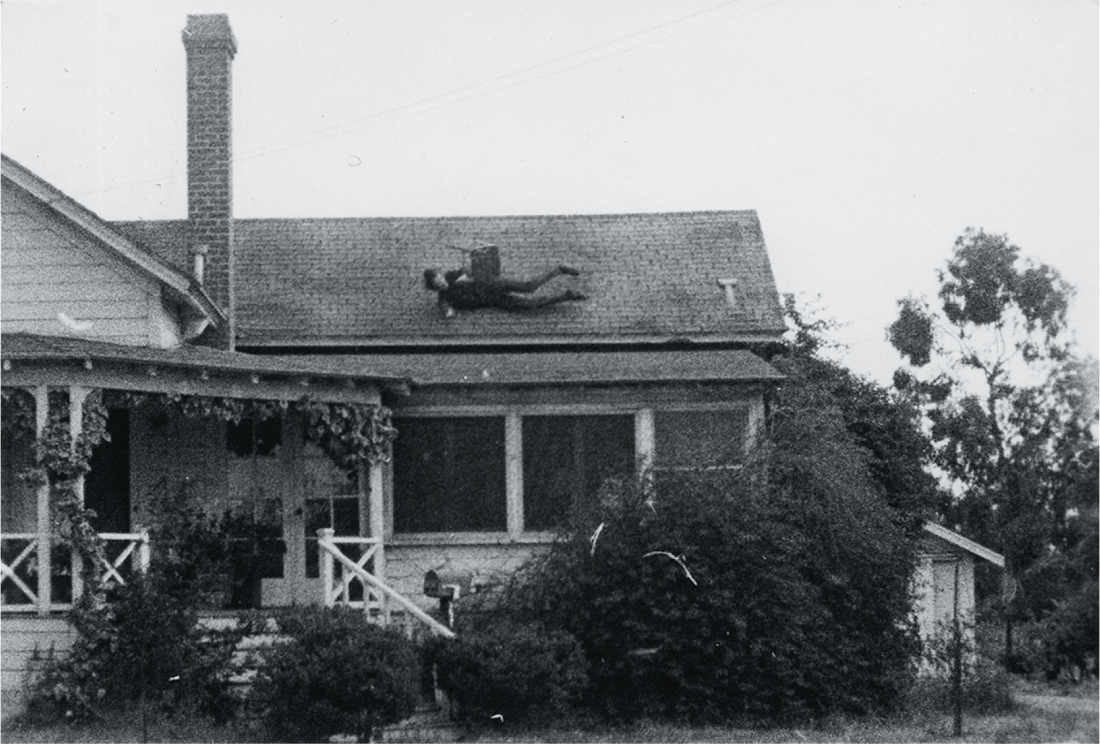Bas Jan Ader
“The waves fell; withdrew and fell again, like the thud of a great beast stamping.” –Virginia Woolf, The Waves
In 1960, the French artist Yves Klein spliced two photo negatives to print a single image of himself swan diving off a rooftop onto an empty sliver of road in a Paris suburb. Klein walked away unscathed; in truth, he fell onto a tarpaulin held out by friends below. Leap into the Void, Klein’s black and white photograph, is an illusion—a nod to Icarian death—with no physical impact or imprint.
Unlike Klein, the Dutch artist Bas Jan Ader filmed himself tumbling off rooftops onto the ground and pitching himself over canal banks into shallow water, repeatedly. Nothing broke his falls. But Ader’s work is not a study in falling alone, or an obsession with man’s fall from grace, so much as it is a series of attempts at reaching a sublime state through falling. Always gathering speed and motion, he makes moves to be absorbed into his landscapes. Walking a line between awe and terror, his experimental falls are more elemental and vulnerable than Klein’s illusion—they come closer to Francis Alÿs’s attempts to enter the centre of a tornado.

Bas Jan Ader, Studies on the Road to a new Neo Plasticism, 1971, set of two colour vintage prints, 3.5 x 3.5 inches (each image). Copyright The Estate of Bas Jan Ader / Mary Sue Ader Andersen, 2016 / The Artist Rights Society (ARS), New York. Courtesy Metro Pictures, New York and Meliksetian | Briggs, Los Angeles.
From June to August 2016, Metro Pictures hosted Ader’s first solo show in the US in over a decade. The renowned curator of the exhibition, Helene Winer, was responsible for organizing Ader’s first-ever exhibition in the US in 1972, in Los Angeles, three years before the artist’s disappearance and presumed death at sea. Walking into Metro Pictures, viewers saw a screen to the left of the entrance which ran a loop of black and white films from the 1970s, where Ader falls. The artist dangles and drops from a tree branch; he rocks on a chair and rolls off the roof of a house; he falls sideways onto a sawhorse and into the bushes lining a brick path in Zeeland; he bicycles over the edge of a cobblestoned road, tumbling headlong into an Amsterdam canal. In describing his falls, Ader minced words, saying only, “Gravity made itself master over me.”
The selection of videos, installations and photographs at Metro Pictures was made in collaboration with Ader’s widow, Mary Sue Anderson, and included previously unreleased images from the Dutch artist’s brief career. Right of the entrance hung a silver-gelatin print of Ader entitled The Artist as Consumer of Extreme Comfort, 1968, showing the artist poking fun at his own anxieties. The composition is an ode to Albrecht Dürer’s spiritual self-portrait, an engraving of the old master with a dog curled at his feet. Dürer looks up from his workbook to meditate on a seascape—the word “melancholia” in the sky above, ablaze. In Ader’s self-portrait, seated in the same pose, dog and all, he looks away from the viewer and his book to contemplate the fireplace. He mocks his own melancholy in the title, and the coziness of the scene amplifies the humour; relaxing indoors, Ader is out of his element.

Bas Jan Ader, Studies on the Road to a new Neo Plasticism, 1971, set of two colour vintage prints, 3.5 x 3.5 inches (each image). Copyright The Estate of Bas Jan Ader / Mary Sue Ader Andersen, 2016 / The Artist Rights Society (ARS), New York. Courtesy Metro Pictures, New York and Meliksetian | Briggs, Los Angeles.
Ader’s work also refers to Piet Mondrian with comic admiration. The rare notes of colour in the Metro Pictures show are taken from a primary palette— reds, yellows and blues—with Ader himself often dressed in black from head to toe, embodying Mondrian’s classic line. In the silent film Primary Time, 1974, we see Ader in black arranging and rearranging red, yellow and blue flowers, re-enacting and teasing Mondrian’s compositional process. The two-part photograph Studies on the Road to Neo Plasticism, 1971, shows Ader, again in black, lying face down on a path, adjacent to an image of him face down on a blue sheet, his limbs bent at right angles, with a yellow block at his left hand and a red block at his right calf.
Clipped phrases echoing failed or futile sentiments also riddled the gallery walls. Aphorisms suit Ader’s style for their ability to open worlds of possibility while offering no resolve. One read, “Thought unsaid, then forgotten,” while below it every week a case of fresh flowers was placed and left to wilt. The words “Please don’t leave me” stood out in black on the main gallery wall, lit by a messy string of lights. It remains eerily unclear whether the message is in Ader’s voice, or rather a plea from those he repeatedly threatened to leave behind in his persistent and aggressive blending of life and art.

Fall 1, Los Angeles (Book Set), 1970, set of 10 black and white vintage prints, 3.5 x 5 inches (each image). Copyright The Estate of Bas Jan Ader / Mary Sue Ader Andersen, 2016 / The Artist Rights Society (ARS), New York. Image courtesy Metro Pictures, New York and Meliksetian | Briggs, Los Angeles.
Personal risk played a huge role throughout Ader’s career. Philosophically in sympathy with Robert Smithson’s land-art practice, Ader sought vanishing points everywhere. He searched for the sublime in LA, in forests and oceans, and attempted to insert himself—to fall—into its unknown. In July 1975, he said goodbye to his wife and set sail for Falmouth, England, from the coast of Massachusetts, alone aboard the Ocean Wave, a mere 12-anda- half-foot fibreglass sailboat (humbly named Guppy 13 by its manufacturers). The transatlantic sail was intended to be the second part of the triptych In Search of the Miraculous. At 33, only a few years into his career, Ader famously disappeared in the Atlantic Ocean.
Standing out at Metro Pictures, the dual slide projection Untitled (Swedish fall) held a dark resonance with the intended “Miraculous” series. The first slide shows Ader standing in a forest between tall Swedish pines, while the next has him lying flat, man down, alongside a freshly felled pine. The poet Edward Hirsch describes the sublime as “something that takes us beyond ourselves, something boundless, the transporting blow.” Ader’s search for the blow of the sublime will never end. In 2010, the artist Ahmet Ögüt staged a public art project entitled Guppy 13 vs. Ocean Wave: A Bas Jan Ader Experience, in which people could sail a model of the same tiny sailboat alone down an Amsterdam canal. This exhibition demonstrates that the solitude in Ader’s work goes far beyond sailing across the ocean alone; it operates as a fact of life in every piece—each holding a longing that thuds on unanswered. ❚
“Bas Jan Ader” was exhibited at Metro Pictures, New York, from June 21 to August 5, 2016.
Georgia Phillips-Amos is a British- American writer. She grew up in Málaga, Spain and Long Island, New York, and has worked at Verso Books and New Directions.

